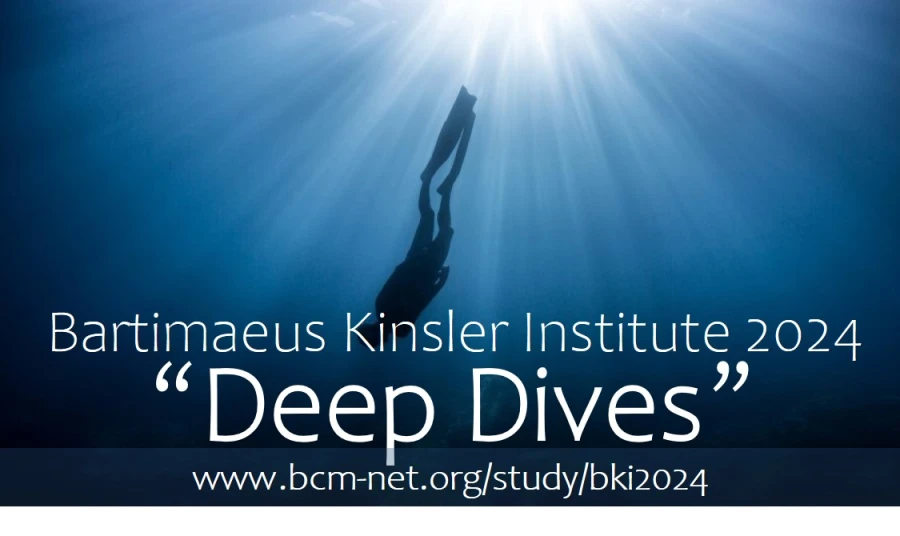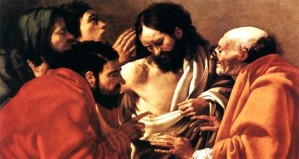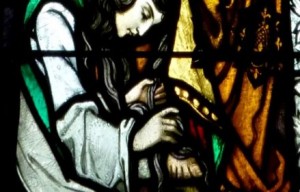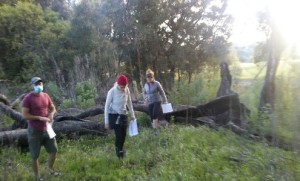Part III. Holy Saturday: Gathering amidst Death and Lockdown, Jesus as Prison Chaplain
That same hour they got up and returned to Jerusalem; and they found the eleven and their companions gathered together. (Luke 24:33)
In a beautiful live-streamed Holy Saturday service from Sabeel Jerusalem this morning, Naim Ateek pointed out that despite Jesus’ death and the necessity of sequestering themselves away from the authorities, the disciples found a way to be together. Community trumps lock down. Good to remember in these days, however we gather.
The church’s very first task was struggling to navigate their fear, anxiety and uncertainty in a world ruled, by all accounts, by the imperial death machine. Feelings not unknown to us amidst this pandemic. Meanwhile, as his followers tried to prop each other up, Jesus continued his journey of forging community among outcasts, according to early Christian tradition. First Peter tells us mysteriously:
He was put to death in the flesh, but made alive in the spirit, in which also he went and made a proclamation to the spirits in prison…
…this is why the gospel was preached even to the dead, that though judged in the flesh, they might live in the spirit like God. (1 Peter 3:18-19; 4:6)
Somehow through the fog of death, Jesus reached out in solidarity with all who have ever been incarcerated.
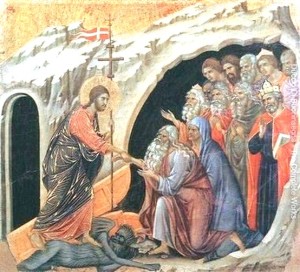 This admittedly obscure assertion defies our theological imaginations, which is why the church dares consider it—and then only with trepidation—on Holy Saturday. But the notion did make it into the Apostle’s Creed (“He descending into hell…”), and I sense it preserves something profound, however inscrutable. (Left: “Descent to Hell” by Duccio, ca.1308 C.E.)
This admittedly obscure assertion defies our theological imaginations, which is why the church dares consider it—and then only with trepidation—on Holy Saturday. But the notion did make it into the Apostle’s Creed (“He descending into hell…”), and I sense it preserves something profound, however inscrutable. (Left: “Descent to Hell” by Duccio, ca.1308 C.E.)
Elaine and I have often speculated that perhaps the various metaphors in the New Testament (Hell/Sheol/Hades/Gehenna) represent ciphers for a period of afterlife we call (only half in jest) “cosmic Restorative Justice Camp.” Why not time and space to: confess sins and crimes great and small, personal and political; make things right; repair inner and outer brokenness; purge ourselves of apathy and compulsions, complicity and denial? (Quakers once imagined something like this in their “penitentiary” experiments, but these were soon coopted by the dominant dehumanizing punishment system of empire.) If we all have need of such mending in our here and now, how much more so after our days are done?
Even when we abandon dysfunctional retributive atonement theologies for restorative ones (on this, see our Ambassadors of Reconciliation I, chapters 3 and 4), we nevertheless still insist that Creator is characterized by justice. And this means that there surely must come some form of ultimate accountability—even if “love wins” in the end.
The work of repentance, restitution and reparation is searing—hence the “flames” in traditional imagery. As Elaine’s colleague Joe Avila described it, meeting the family of the young woman he killed in a drunk driving accident “was a fire I would not like to walk through again.” But for equity to be fully realized and enmity to be dissolved—for the universe finally to bend into justice—the hard labor of personal and political restoration must be fully realized. No exceptions.
The good news: Jesus visits all those “in prison” past, present and to come: jailers and their bosses as well as the caged; the almost innocent as well as the massively guilty; the tormented as well as torturers; me and you. Blessed be the Crucified One, chaplain of Restorative Justice Camp, in this life and beyond.
